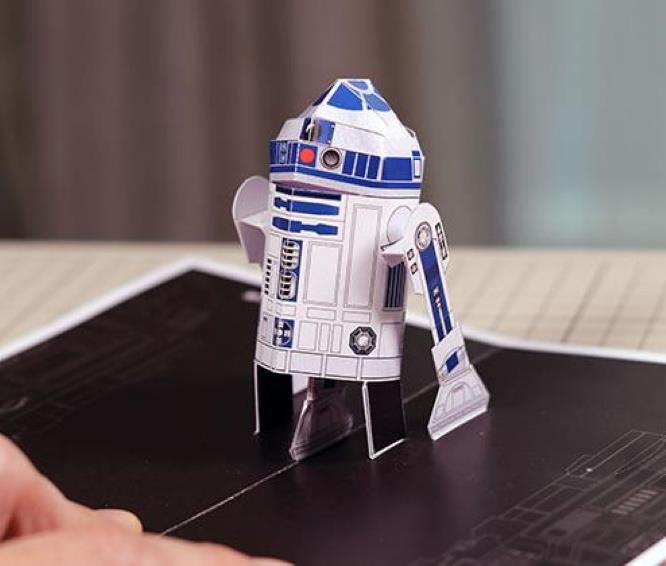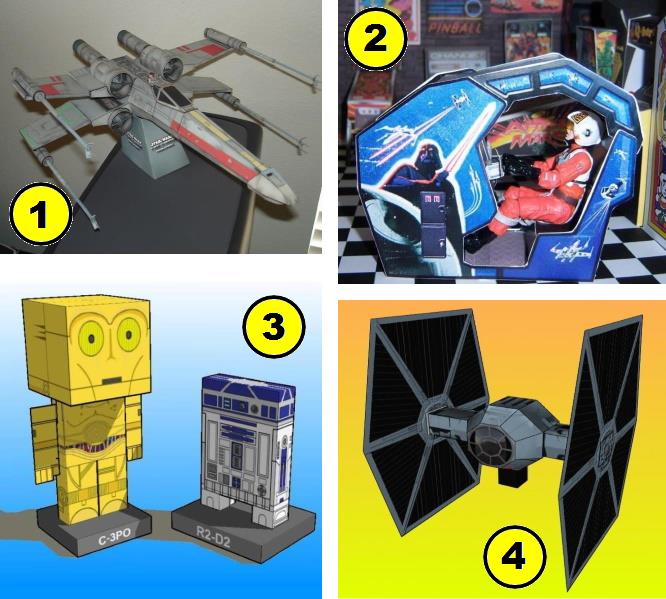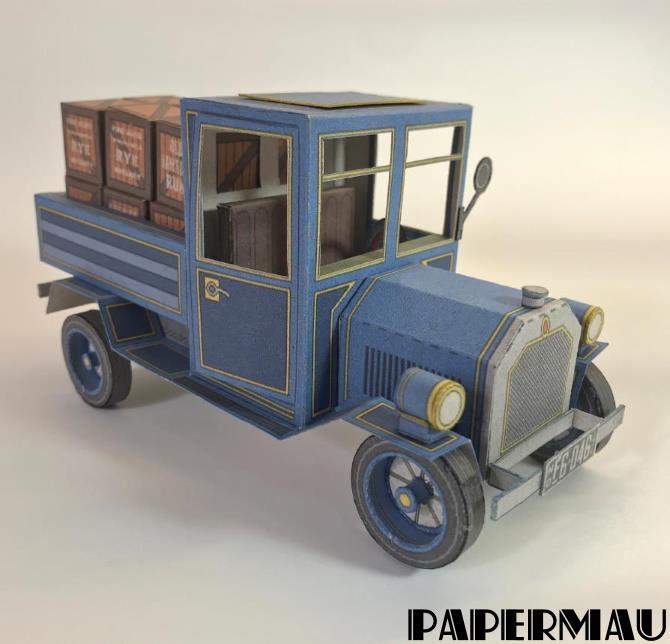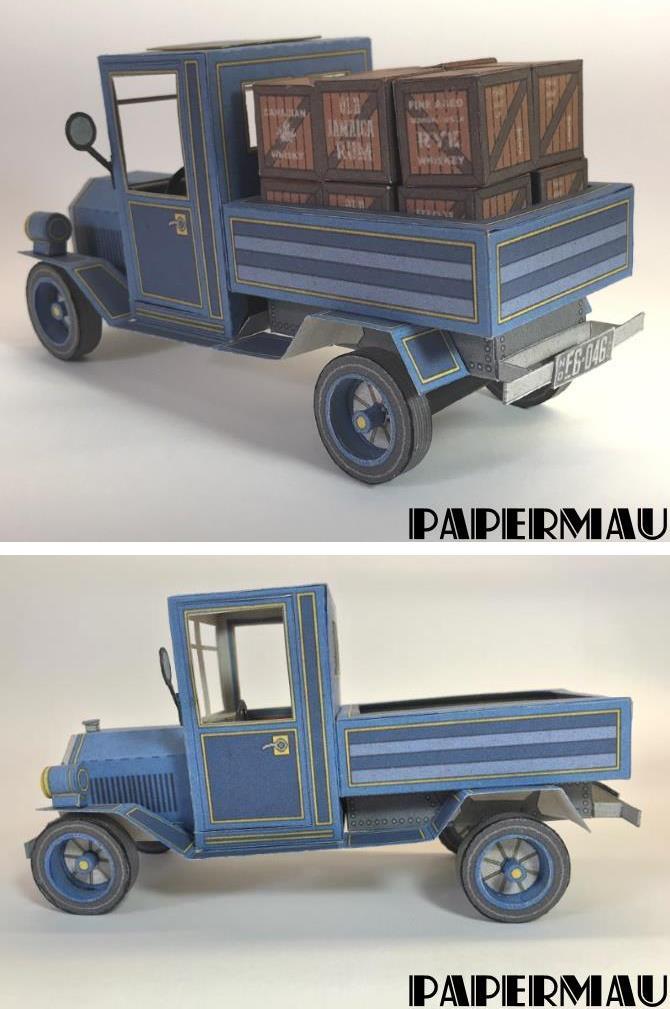This model draft was created in Sketchup, just the basic lines, which was then "disassembled" in Pepakura Designer and then properly worked on, receiving textures, tabs and small corrections in MsPaint.
I printed the templates on 180-weight sheets on an Epson printer, in normal quality. I advise you to print on sheets weighing at least 150 grams, but you can also print on regular office paper and then reinforce these sheets by gluing them to cereal packaging paper, etc.
The model is not difficult to assemble. Maybe some people get a little confused with the wheels, it's always a boring, repetitive thing to put together, but it's part of the hobby and it's a good workout in patience and manual skill.
I didn't make illustrated instructions, but the basics are: pieces are named with letters that fit into pieces with the same letters. Other parts are named for what they are, so if you know what a vehicle is, you have a basic idea of where these parts go. I hope the photos that illustrate this document help those interested in building this little truck.
I had a lot of fun, both creating and assembling it, and I hope you can forget a little about the day-to-day problems assembling it, alone or with your children.
You will find that the satisfaction of transforming flat sheets of paper into a three-dimensional object is very good.
It is not monetary, there will be no applause, but there will be a very good feeling of personal achievement and overcoming. It's like giving yourself a gift. As I usually say, it's good and cheap therapy. Have fun.
Mauther
During the Prohibition era in the United States (1920-1933), when the production, sale, and transportation of alcoholic beverages were prohibited, illegal transportation of alcohol often involved creative and covert methods.
The vehicles used to transport illegal drinks across the U.S. border were commonly referred to as "rum-runners" or "bootleggers."
Alcoholic beverages came from countries where it was legal to produce them or were produced clandestinely within the USA.
The clandestine producers became known as Moonshiners.
To avoid detection by law enforcement, rum-runners often modified their vehicles to increase speed and stealth. Some popular modifications included souping up engines, adding hidden compartments, or employing other tactics to outsmart authorities.
The term "bootlegger" itself originated from the practice of concealing flasks of alcohol in the tops of their boots. In addition to land transportation, smuggling also occurred by sea, with boats known as "rum-rowers" or "rum-chasers" involved in transporting illegal alcohol.
These activities contributed to the rise of organized crime during the Prohibition era.
As it often happens, the hand of the State meddling where it shouldn't and making everything worse.
O rascunho deste modelo foi criado no Sketchup, apenas as linhas básicas, que depois foi "desmontado" no Pepakura Designer e então devidamente trabalhado, recebendo texturas, abas e pequenas correções no MsPaint.
Eu imprimí os templates em folhas de gramatura 180 em uma impressora Epson, na qualidade normal. Eu aconselho que você imprima em folhas de no mínimo 150 gramas, mas você também pode imprimir em papel regular, de escritório, e depois reforçar essas folhas colando-as em cartolina, papel de embalagens de cereais, etc.
O modelo não é difícil de montar. Talvez algumas pessoas se atrapalhem um pouco com as rodas, sempre uma coisa chata de montar, repetitiva, mas faz parte do hobby e é um bom treino de paciência e habilidade manual.
Não fiz instruções ilustradas, ma o básico é: peças são nomeadas com letras que se encaixam em peças com as mesmas letras. Outras peças são nomeadas pelo que são, então se você sabe o que é um veículo, você tem uma idéia básica de onde estas peças vão.
Espero que as fotos que ilustram o PDF ajudem aqueles que se interessarem em construir este pequeno caminhão.
Eu me diverti muito, tanto o criando quanto o montando, e espero que vocês possam esquecer um pouco dos problemas do dia a dia o montando, sozinhos ou com suas crianças.
Vocês verão que a satisfação de transformar folhas planas de papel em um objeto tridimensional é muito boa.
Não é monetária, não haverá aplausos, mas haverá um sentimento muito bom de realização pessoal e superação. É como dar um presente para você mesmo. Como eu costumo dizer, é terapia boa e barata. Divirtam-se.
Mauther
Durante a "Lei Seca", a era da Proibição nos Estados Unidos (1920-1933), quando a produção, venda e transporte de bebidas alcoólicas eram proibidos, o transporte ilegal de álcool frequentemente envolvia métodos criativos e secretos.
Os veículos usados para transportar bebidas ilegais através da fronteira dos EUA eram comumente chamados de "rum-runners" ou "bootleggers" (contrabandistas).
As bebidas alcoolicas vinham de países onde era legal produzí-las ou era produzido clandestinamente dentro dos EUA.
Os produtores clandestinos ficaram conhecidos como Moonshiners.
Para evitar a detecção por parte das autoridades, os rum-runners frequentemente modificavam seus veículos para aumentar velocidade e furtividade. Algumas modificações populares incluíam potencializar os motores, adicionar compartimentos escondidos ou empregar outras táticas para ludibriar as autoridades.
O termo "bootlegger" em si originou-se da prática de esconder frascos de álcool nas partes superiores de suas botas. Além do transporte terrestre, o contrabando também ocorria por mar, com barcos conhecidos como "rum-rowers" ou "rum-chasers" envolvidos no transporte ilegal de álcool.
Essas atividades contribuíram para o aumento do crime organizado durante a era da Proibição.
É, como na maioria das vezes acontece, a mão do Estado se metendo aonde não devia e piorando tudo.
Download: The Rum-Runner - Oldtimer Pickup Truck Paper Model - by Papermau - Download Now!
Below, more two posts about the Rum-Runner Oldtimer Pickup Truck Paper Model:


































